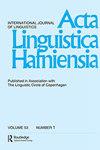The regrammation of paradigms: the development of auxiliaries in Danish
Q2 Arts and Humanities
引用次数: 2
Abstract
Abstract This article surveys the development of voice and tense auxiliaries in Scandinavian with a focus on Danish. Voice is the first category (documented indirectly by Gothic) to show periphrastic forms in paradigmatic cooperation with inflectional forms; and these periphrastic forms are modelled on predicative constructions. Modern Danish has introduced verbal constructions at the expense of all predicative morphology, and the Old Scandinavian auxiliary verbs hafa/hava ‘have’ and vera/wæra ‘be’, verða/wartha ‘become’ have undergone semantic changes, including specialisation and markedness shift. This regrammation process involves semantic changes that must be described in terms of paradigm (re)organisation and cannot be captured in terms of changes along the parameters of the cline of grammaticalisation. Two main types of auxiliaries are distinguished: inflectional auxiliaries, with predication scope (tense, mood and voice) as part of otherwise inflectional paradigms, and, constructional auxiliaries (copula verbs) with predicate scope. Modern Danish inflectional auxiliaries express perfect tense and active voice with transitive verbs (have ‘have’), perfect tense, active voice and telicity with intransitive verbs (være ‘be’ and have ‘have’), stativity (copula verbs være ‘be’ and blive ‘become, turn’) and passive voice and telicity in the periphrastic passive (være ‘be’ and blive ‘become, be’). Their meaning potentials differ according to the paradigms they are part of.范式重组:丹麦语助词的发展
摘要本文以丹麦语为研究对象,考察了斯堪的纳维亚语中语态助动词和时态助动词的发展。语态是第一类(由哥特间接记录)表现出与屈折形式合作的迂回形式;这些委婉形式是模仿谓语结构的。现代丹麦语以牺牲所有谓语形态为代价引入了动词性结构,古斯堪的纳维亚助动词hafa/hava“有”和vera/wæra“be”,ver /wa /wartha“成为”经历了语义变化,包括专业化和标记转移。这种重组过程涉及语义变化,必须用范式(重新)组织来描述,而不能用沿着语法化变化的参数来描述。主要有两种类型的助词:屈折式助词,其谓语范围(时态、语气和语态)是屈折式助词范式的一部分;构词式助词(连词动词)具有谓语范围。现代丹麦语屈折助动词用及物动词(have have)表达完成时和主动语态,用不及物动词(være be和have have)表达完成时、主动语态和远性,用连动动词være be和believe变成,turn)表达定态和远性,用委婉被动语态表达被动语态和远性(være be和believe变成,be)。它们的意义潜力根据它们所处的范式的不同而不同。
本文章由计算机程序翻译,如有差异,请以英文原文为准。
求助全文
约1分钟内获得全文
求助全文
来源期刊

Acta Linguistica Hafniensia
Arts and Humanities-Language and Linguistics
CiteScore
0.90
自引率
0.00%
发文量
5
 求助内容:
求助内容: 应助结果提醒方式:
应助结果提醒方式:


